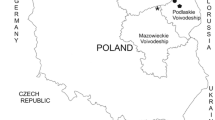Abstract
The Mo contents and the relations between Mo and Cu or Crcontents were investigated in the organs of Japanese wild ducks(spotbill duck, pintail, wigeon, scaup and tufted duck). Thehighest Mo content in kidney and liver of the dabbling duckswere more than 30 μg g-1 dry weight (μg g-1 d.wt.), though that of diving ducks were less than 11 μgg-1 d. wt. The contents were lower in the ducks migratingwithin Japan, Eurasia and North America than those in the birdsmigrating between Japan and Eurasia. The contents of liver inall species were more than 50 and less than 5 μg g-1 d.wt. for Cu and Cr, respectively. Significant correlations werefound between Mo and both elements in pintail and scaup, and Moand Cr in tufted duck. These results suggest that thecontamination of wild ducks reflects the reproductive area, andnot the collected area. Mo contents closely correlated with theCu and/or Cr contaminations.
Similar content being viewed by others
References
Berger, K. C.: 1962, 'Micronutrient deficiencies in the United States', J. Agric. Food Chem. 10, 178–181.
Bourgoin, B. P. and Risk, M. J.: 1987, 'Vanadium contamination monitored by an Arctic bivalve cyrtodaria kurriana', Bull. Environ. Contam. Toxicol. 39, 1063–1068.
Britton, J. W. and Goss, H.: 1946, 'Chronic molybdenum poisoning in cattle', J. Amer. Vet. Med. Assoc. 108, 176–178.
Farrand Jr., J.: 1988, Western Birds, Chanticleer Press, Inc., New York.
Fukuda M.: 1996, 'Spotbill Duck, Pintail, Wigeon', in: H. Higuchi, H. Morisaka and S. Yamagishi (eds), The Encyclopedia of Animals in Japan, Vol. 3: Birds I, T. Hidaka, pp. 73–74. Heibonsha Limited Publishers, Tokyo, Japan (in Japanese).
Hui, C. A.: 1998, 'Elemental contamination in the livers and ingesta of four subpopulations of the American coot (Fulica americana): An herbivorous winter migrant in San Francisco Bay', Environ. Poll. 101, 321–329.
Hui, C. A., Takekawa, J. Y., Baranyuk, V. V. and Litivin, K. V.: 1998, 'Trace element concentration in two subpoppulations of lesser snow geese fromWrangel Island. Russia', Arch. Environ. Contam. Toxicol. 34, 197–203.
Hutton, M.: 1981, 'Accumulation of heavy metals and selenium in three seabird species from the United Kingdom', Environ. Poll. 26, 129–145.
IES: 2001, Introduction to Environmental Science, Nihonkankyogakkai-hensyui inkai (eds), Yuhikaku Tokyo Japan (in Japanese).
Kaneda, H.: 1996, 'Scaup, Tafted Duck', in: T. Hidaka, H. Higuchi, H. Morisaks and S. Yamagishi (eds), The Encyclopedia of Animals in Japan Vol. 3: Birds I, pp. 78, Heibonsha Limited Publishers, Tokyo, Japan (in Japanese).
Kim, E. Y., Goto, R., Tanabe, S., Tanaka, H. and Tatsukawa, R.: 1988, 'Distribution of 14 elements in tissues and organs of oceanic seabirds', Arch. Environ. Contam. Toxicol. 35, 638–645.
Mochizuki, M., Hondo, R. and Ueda, F.: 2001, 'Simultaneous analysis for multiple heavy metals contaminated biological samples', Biol. Trace. Elem. Res. (submitted).
Mochizuki, M., Sasaki, S., Ueda, F. and Hondo, R.: 1999, 'Vanadium contamination and the relation between vanadium and other elements in wild birds', Environ. Poll. 106, 249–251.
Mochizuki, M., Ueda, F. and Hondo, R.: 1998, 'Vanadium contents in organs of wild birds', J. Trace Elem. Exp. Med. 11, 431.
NAS: 1977, 'Medical and Biological Effects of Environmental Pollutants, Copper', in: National Academy of Science. National Research Council, Division of Chemistry and Chemical Technology-Environmental Studies Board, Washington. Tokyo Kagaku Dojin (trans. in Japanese), pp. 1–100.
Norheim, G.: 1987, 'Levels and interactions of heavy metals in sea birds from Svalbard and the Antarctic', Environ. Poll. 47, 83–94.
Takano, T., Hamaguchi, T., Morioka, T., Kanouchi, T. and Kabaya, T.: 1993, 'Wild Birds in Japan', 2nd ed., YAMA-KEI Publishers, Japan (in Japanese), 591 pp.
Takeuchi, S. and Arakawa, Y.: 1990, Trace Elements in Gastroenterology, Shinko Igaku Shuppan Tokyo (in Japanese), 191 pp.
Wren, C. D.: 1986, 'Mammals as biological monitors of environmental metal levels', Environ. Monit. Asses. 6, 127–144.
Zakrzewski, S. F.: 1991, 'Principles of Environmental Toxicology', Kagaku Dojin Kyoto, Japan (trans. in Japanese).
Author information
Authors and Affiliations
Corresponding author
Rights and permissions
About this article
Cite this article
Mochizuki, M., Sasaki, R., Yamashita, Y. et al. The Distribution of Molybdenum in the Tissues of Wild Ducks. Environ Monit Assess 77, 155–161 (2002). https://doi.org/10.1023/A:1015871802566
Issue Date:
DOI: https://doi.org/10.1023/A:1015871802566




